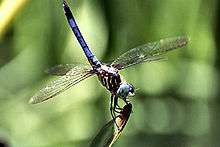Blue dasher
| Blue dasher | |
|---|---|
 | |
| Male with raised abdomen that may be a threat display or a response to heat (the obelisk posture) | |
 | |
| Female | |
| Scientific classification | |
| Kingdom: | Animalia |
| Phylum: | Arthropoda |
| Class: | Insecta |
| Order: | Odonata |
| Suborder: | Anisoptera |
| Family: | Libellulidae |
| Genus: | Pachydiplax |
| Species: | Pachydiplax longipennis |
The blue dasher (Pachydiplax longipennis) is a dragonfly of the skimmer family. It is common and widely distributed in the United States and Canada.[1]
Mature males develop a bluish-white pruinescence on the dorsal side of the abdomen and, in western individuals, on the thorax. They display this pruinescence to other males as a threat while defending territories at the edge of the water.[2]

Although the species name longipennis means "long wings", the wings are not substantially longer than those of related species. Females do, however, have a short abdomen that makes the wings appear longer in comparison.[1] The blue dasher grows up to 25–43 mm long. Juvenile males will show female coloration before they turn blue. Females are paired with yellow stripes on the dorsal side of the first 8 abdominal segments, the part of the body that lies between the thorax and the pelvis and encloses the stomach, intestines, liver, spleen, and pancreas; more commonly known as the belly. Females are also reported to turn blue, but at a slower rate then the males.
Life cycle
As the blue dasher ages, the wings will wear and tear. Females will lay eggs in the aquatic vegetation. Their life span is usually year
Range
They range mostly in the United States, but have been seen in Canada. They are absent from the Dakotas, and the Rocky Mountain region. Range will continue through Mexico.

Habitat
They are found by ponds, lakes, marshes, and bogs. They can also be found in almost aywhere when there is still water. Larvae are very tolerant of wetlands with poor water quality and low dissolved-oxygen levels.
Seasons
They are mostly a summer species.
Food
These dragonflies primarily eat tiny flying insects.
Reproduction
After a males and a female mate, the female flies singly, without the male attached, to lay her eggs by dipping the tip of her abdomen in the water while hovering above its surface.
Ecology
"The naiads live in submerged vegetation. They do not actively pursue prey but wait for it to pass by, a strategy which affords them protection from other predators. The naiads of this species can tolerate water with low oxygen content. This is used by biologists in Florida who interpret their presence as a possible indicator of low water quality. Naiads emerge as adults at night. Adults generally fly from late June to October. Hunting occurs from perches on twigs and rocks. This is the only member of this genus." http://imnh.isu.edu/DIGITALATLAS/bio/insects/drgnfly/libefam/palo/palo.htm
Diet
They will eat just about anything, but their favorite meals are mosquito larvae. The meals change when they hatch into adults, but the insatiable appetite does not.
References
| Wikimedia Commons has media related to Pachydiplax longipennis. |
| External identifiers for Pachydiplax longipennis | |
|---|---|
| Encyclopedia of Life | 1034398 |
| Also found in: Wikispecies | |
- 1 2 Needham, James G.; Minter J. Westfall, Jr.; Michael L. May (2000). Dragonflies of North America (rev. ed.). Gainesville, FL: Scientific Publishers. pp. 762–763. ISBN 0-945417-94-2.
- ↑ Johnson, Clifford (1962). "A Study of Territoriality and Breeding Behavior in Pachydiplax longipennis Burmeister (Odonata:Libellulidae)". The Southwestern Naturalist. Southwestern Association of Naturalists. 7 (3/4): 191–197. doi:10.2307/3668841. JSTOR 3668841.